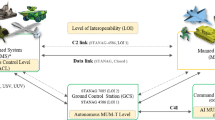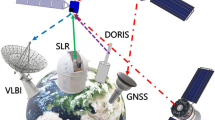Abstract
Planetary atmospheric aerobraking will most likely be incorporated in every future Mars orbiting mission. Aerobraking requires an intensive workload during operations. To provide safe and efficient aerobraking, both navigation and spacecraft system teams must be extremely diligent in updating spacecraft sequences and performing periapsis raise or lower maneuvers to maintain the required orbital energy reduction without exceeding the design limits of the spacecraft. Automating the process with onboard measurements could significantly reduce the operational burden and, in addition, could reduce the potential for human error. Two levels of automation are presented and validated using part of the Mars Global Surveyor aerobraking sequence and a simulated Mars Odyssey sequence. The simplest method only provides the capability to update the onboard sequence. This method uses onboard accelerometer measurements to estimate the change in orbital period during an aerobraking pass and thereby estimates the beginning of the next aerobraking sequence. Evaluation of the method utilizing MGS accelerometer data showed that the time of the next periapsis can be estimated to within 25% 3σ of the change in the orbital period due to drag. The second approach provides complete onboard orbit propagation. A low-order gravity model is proposed that is sufficient to provide periapsis altitude predictions to within 100–200 meters over three orbits. Accelerometer measurements are used as part of the trajectory force model while the spacecraft is in the atmosphere.
Similar content being viewed by others
References
WILLCOCKSON, W. H. “Magellan Aerobraking Control Corridor—Design and Implementation,” presented as paper AAS 94-117 at the AIAA/AAS Space Flight Mechanics Meeting, February 14–16, 1994.
LYONS, D. T. “Aerobraking Magellan: Plan versus Reality,” presented as paper AAS 94-118 at the AAS/AIAA Space Flight Mechanics Meeting, Cocoa Beach, Florida, February 14–16, 1994.
BEERER, J., BROOKS, R., ESPOSITO, P., LYONS, D., SIDNEY, W., CURTIS, H., and WILLCOCKSON, W. “Aerobraking at Mars: the MGS Mission,” presented as paper AIAA 96-0334 at the AIAA 34th Aerospace Sciences Meeting, Reno, NV, Jan. 15–18, 1996.
TOLSON, R. H., KEATING, G. M., CANCRO, G. J., PARKER, J. S., NOLL, S. N., and WILKERSON, B. L. “Application of Accelerometer Data to Mars Global Surveyor Aerobraking Operations,” Journal of Spacecraft and Rockets, Vol 36, No. 3, May–June, 1999, pp. 323–329.
LYONS, D. T. “Mars Global Surveyor: Aerobraking with a Broken Wing,” presented as paper AAS 97-618 at the AIAA/AAS Astrodynamics Specialists Conference, Sun Valley, ID, August 4–7, 1997.
LYONS, D. T. “Aerobraking Automation Operations,” presented as paper AAS 01-385 at the AAS/AIAA Astrodynamics Specialists Conference, Quebec City, Canada, July 30–August 2, 2001.
BATTIN, R., An Introduction to the Mathematics and Methods of Astronautics, AIAA Education Series, 1987.
JOHNSON, M., and WILLCOCKSON, W. H. “Mars Odyssey Aerobraking: The First Step Towards Autonomous Aerobraking Operations,” to be presented at the AAS/AIAA Astrodynamics Specialists Conference, Big Sky, Montana, Aug 3–7, 2003.
TOLSON, R. H., KEATING, G. M., NOLL, S. N., BAIRD, D. T., and SHELLENBERG, T. J. “Utilization of Mars Global Surveyor Accelerometer Data for Atmospheric Modeling,” presented as paper AAS 99-306 at the AAS/AIAA Astrodynamics Specialists Conference, Girdwood, Alaska, August 16–19, 1999.
DWYER, A. M., TOLSON, R. H., MUNK, M. M., and TARTABINI, P. V. “Development of a Monte Carlo MarsGRAM Model for Mars 2001 Aerobraking Simulations,” presented as paper AAS 01-389 at the AAS/AIAA Astrondynamics Specialists Conference, Quebec City, Canada, July 30–August 2, 2001.
Author information
Authors and Affiliations
Rights and permissions
About this article
Cite this article
Hanna, J.L., Toison, R.H. Approaches to Autonomous Aerobraking at Mars. J of Astronaut Sci 50, 173–189 (2002). https://doi.org/10.1007/BF03546261
Published:
Issue Date:
DOI: https://doi.org/10.1007/BF03546261




